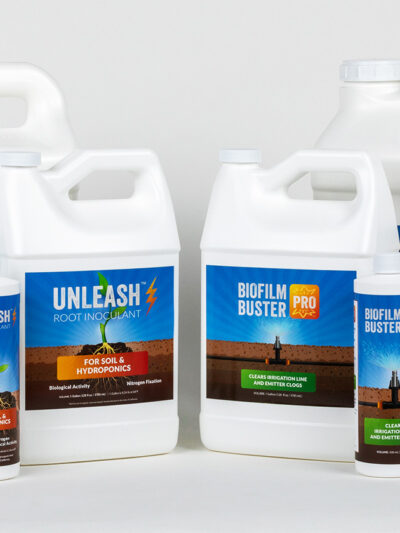Root inoculant products – such as Unleash Root Inoculant – are comprised of plant-beneficial microbes, providing significant gains in crop yield and quality by making nutrients available for plant uptake and through other mechanisms. One of the most difficult nutrients for plants to take up in sufficient quantities is Phosphorous (P). Plants require large amounts of phosphorous (P) for healthy growth and development, with only nitrogen and potassium required in higher quantities. P is an essential part of several compounds involved in new cell growth such as DNA and RNA, and is central to plant energy production. P is also required for root and stalk development, ripening, and flower/seed development. Because of this, plants grown in P-depleted conditions show slow or stunted growth and uneven maturation as the plant take P from older tissue to allow new growth to occur. Plants grown in severely P-depleted conditions can also have bluish green/purple leaves (especially older leaves), and small acidic fruit formation. Note that while severely P-depleted plants show physical signs that can be easily identified, plants grown in less severely depleted conditions do not show signs until harvest, with poor crop yields and/or quality being the final result.
So why does P depletion occur? Growers – especially commercial growers – use fertilizers containing P. Virtually all P in fertilizer is added to soils in the form of the phosphate anion (PO4-3). Phosphate-containing acids or salts as well as animal manure are common sources of fertilizer phosphate. However, once fertilizer P is added to soils, it rapidly precipitates (solidifies), with only 10%-30% of the fertilizer phosphate being available for plants, referred to as “fixed” phosphate. Phosphate can precipitate with various other minerals in the soil – with calcium, aluminum, carbonate, and iron all playing major roles at different soil pH levels. In high pH conditions P commonly precipitates with calcium, and with metals in low pH conditions. In both cases, there is limited availability of P to plants. Phosphate is at the highest availability to plants at neutral pH levels, particularly in the high organic carbon conditions typically found in topsoil. However, even under these more ideal conditions, P has limited mobility as it easily complexes with organic carbon such that it cannot readily dissolve into and move with moisture through the soil. This means that plants will only have access to P in the immediate soil surrounding the plant roots, and even this P is complexed with other compounds, requiring additional help to unlock and make available to the plant root system.
So how can P be accessed by plants? Rhizosphere bacteria such as those found in Unleash Root Inoculant play a direct role in phosphate uptake by mobilizing these precipitated phosphate solids. These root-zone bacterial populations require phosphate for their own growth, which makes P available to both the microbes and proximal plant roots. Since phosphate availability is highly pH-dependent, local pH changes in the rhizosphere due to Unleash microbe activity can have a significant effect on the availability of this nutrient. Additionally, Unleash microbes can actively “digest” immobilized P bound to organic carbon or mineral complexes.
Arbuscular mycorrhizae are also known to play a significant role in phosphate uptake by increasing the root surface area, allowing the plant to extend the soil volume that can be reached by the plant roots. In fact, as much as 80% of the phosphate taken up by a mycorrhizal-colonized plant root system is supplied by the fungus. Unleash treatment can significantly improve the ability of mycorrhizae to colonize plant roots by ensuring the plant root zone is able to support mycorrhizal growth, resulting in significantly increased P uptake potential.
Note that some of the most common results seen due to P depletion – poor crop quality, poor maturation uniformity, and slower harvests – are exactly where Unleash treatment can make the largest difference to farmers. Results from Unleash treatment when compared to untreated areas that show significantly improved crop quality include crops as diverse as strawberries, melons, grapes, and many others as shown by representative case studies below.
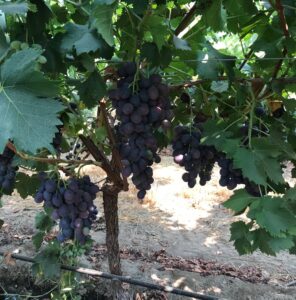
Unleash Treated Table Grapes
Pictured to the right are Unleash-treated table grapes from a 2018 trial in California. Compared to untreated table grapes, Unleash-treated areas had a 55% increase in export-quality grapes – the highest quality grapes with the highest monetary value. Chemical analyses of the soil indicated the Unleash-treated mycorrhizal soil had lower P levels, with little to no differences seen in other major plant nutrients, suggesting the Unleash microbes were better able to mobilize P to the plant roots than native microbes in untreated areas.
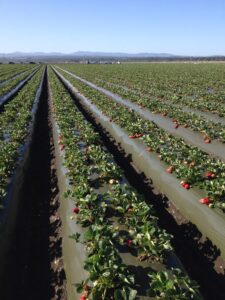
Unleash-treated strawberries were higher quality than untreated strawberries
Pictured to the right are Unleash-treated strawberries from a 2017 trial in California. Trial results showed not only a 23% increase in yield, but also a significant improvement in strawberry quality, as indicated by the charts below:
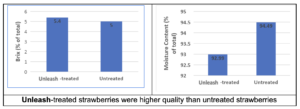
Unleash-treated strawberries had 12.5% improved Brix (sweetness) and lower % moisture than untreated strawberries, indicating higher quality that can get higher prices in the market, and better shelf life.
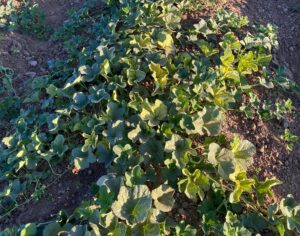 Pictured here are Unleash-treated cantaloupe plants from a 2020 trial in Arizona. Unleash-treated areas had more than double the yield over untreated areas, with significant improvements in crop quality, as indicated in the charts below:
Pictured here are Unleash-treated cantaloupe plants from a 2020 trial in Arizona. Unleash-treated areas had more than double the yield over untreated areas, with significant improvements in crop quality, as indicated in the charts below:
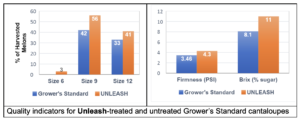
The chart on the left side of this picture shows that Unleash-treated areas had significantly higher percentages of total harvested fruits at sizes 9 and 12 fruits – the highest market value melon sizes than untreated areas. The chart on the right shows that melons from Unleash-treated areas had higher firmness and Brix than melons from untreated areas. Firmness and Brix are major fruit quality indicators that help determine melon value and shelf life.
In summary, Unleash microbes can significantly improve plant health, crop yield and crop quality by increasing phosphate availability to plants. Fertilizer phosphates rapidly form complexes with many different compounds in the soil and water, limiting P availability to the area immediately surrounding plant roots, with even root zone P mostly unavailable for uptake. Unleash microbes can mobilize root zone P through local pH changes and by “digesting” complexed P. Additionally, Unleash microbes can help plants extend the soil volume they can access for nutrients by ensuring the plant root zone is able to support mycorrhizal growth.
American produce farmers and Cannabis growers have been using Unleash Root Inoculant to grow healthy plants for over a decade. Please contact us at info@unleashorganics.com to find out how we can help your pls to reach their optimal growth potential.
Check us out on Instagram, Facebook, and LinkedIn


